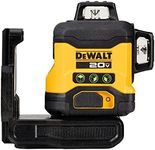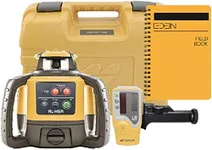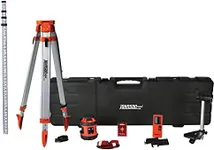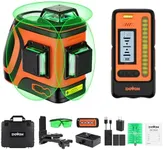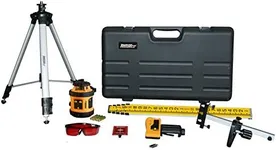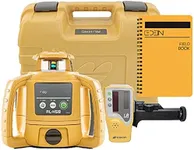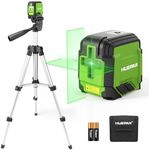Buying Guide for the Best Laser Levels
Choosing the right laser level can make your projects much easier, whether you're hanging pictures, installing shelves, or working on construction sites. The key is to match the features of the laser level to the type of work you plan to do. Understanding the main specifications will help you pick a model that fits your needs and ensures accuracy and efficiency in your tasks.Laser Type (Line, Dot, Rotary)Laser levels come in different types: line lasers project straight lines, dot lasers mark specific points, and rotary lasers spin to create a 360-degree line. Line lasers are great for most indoor tasks like aligning tiles or cabinets, while dot lasers are useful for transferring points from floor to ceiling. Rotary lasers are best for large-scale projects, especially outdoors, like leveling ground or framing. Think about the kind of work you do most often—if it's simple home improvement, a line or dot laser is usually enough, but for bigger construction jobs, a rotary laser might be necessary.
AccuracyAccuracy tells you how close the laser level's line or point is to being perfectly straight or level, usually measured in millimeters per meter or inches per foot. Higher accuracy means less deviation, which is important for precise work like tiling or framing. Basic models might have an accuracy of about 3mm per 10 meters, while professional models can be as precise as 1mm per 10 meters. If your projects require high precision, look for a model with better accuracy, but for general DIY tasks, standard accuracy is often sufficient.
Self-Leveling vs. Manual LevelingSelf-leveling laser levels automatically find and maintain a level line, making setup quick and reducing errors. Manual leveling models require you to adjust them by hand, which can be more time-consuming and less accurate. Self-leveling is especially helpful if you need to move quickly or if the surface isn't perfectly flat. If you want convenience and reliability, self-leveling is the way to go, but if you only use a laser level occasionally and don't mind spending extra time on setup, manual models can work.
RangeRange is the maximum distance the laser can project a visible line or point, usually measured in meters or feet. Shorter ranges (up to 10 meters) are fine for small rooms or indoor projects, while longer ranges (up to 50 meters or more) are better for large spaces or outdoor use. Some models can be used with a detector to extend their range even further. Consider the size of the areas where you'll use the laser level most often—choose a range that covers your typical workspace.
Visibility (Laser Color and Brightness)Laser levels use either red or green lasers. Green lasers are generally brighter and easier to see, especially in well-lit rooms or outdoors, but they may use more battery power. Red lasers are common and work well indoors in normal lighting. If you often work in bright conditions or need to see the line from farther away, a green laser might be better. For most indoor tasks, a red laser is usually sufficient.
Mounting OptionsMounting options refer to how you can set up the laser level—some have built-in stands, magnetic bases, or tripod mounts. A tripod mount gives you flexibility in positioning, while magnetic bases are handy for attaching to metal surfaces. If you need to use the laser level in different locations or on uneven surfaces, look for models with versatile mounting options. Think about where and how you'll use the tool to decide which mounting features are most useful for you.
Durability and Weather ResistanceDurability and weather resistance are important if you plan to use the laser level outdoors or on job sites. Some models are designed to withstand dust, water, and drops, often rated by an IP (Ingress Protection) code. If you work in tough environments or outdoors, look for a model with higher durability and weather resistance. For indoor or occasional use, standard models without special protection are usually adequate.
